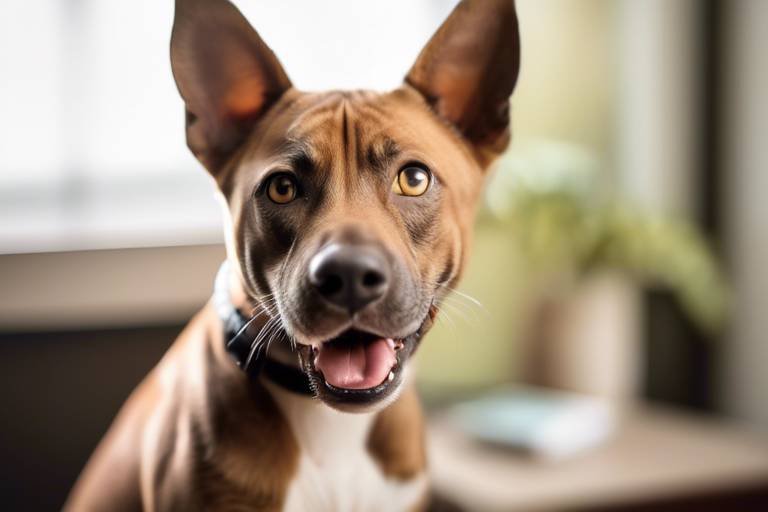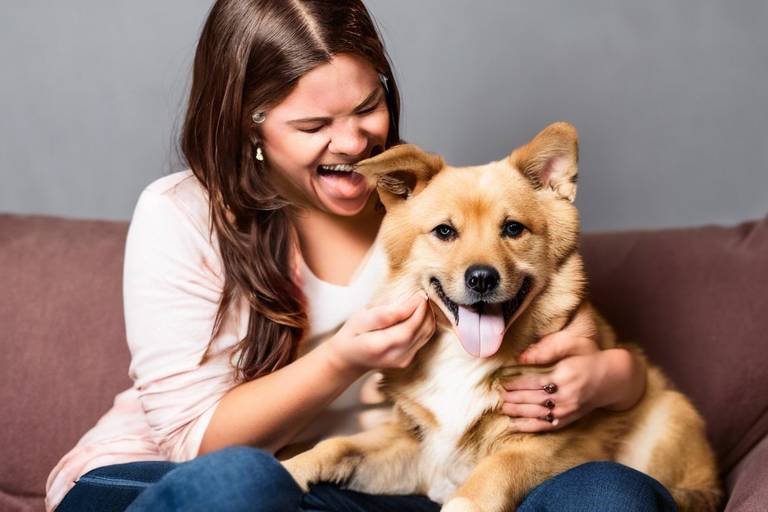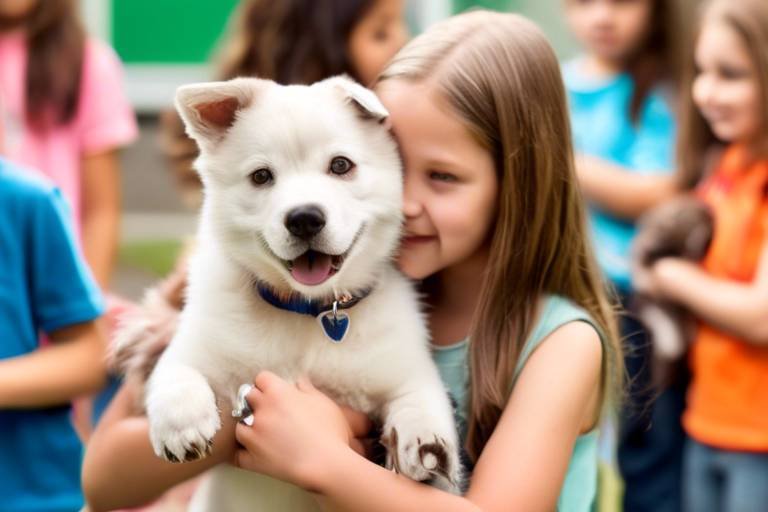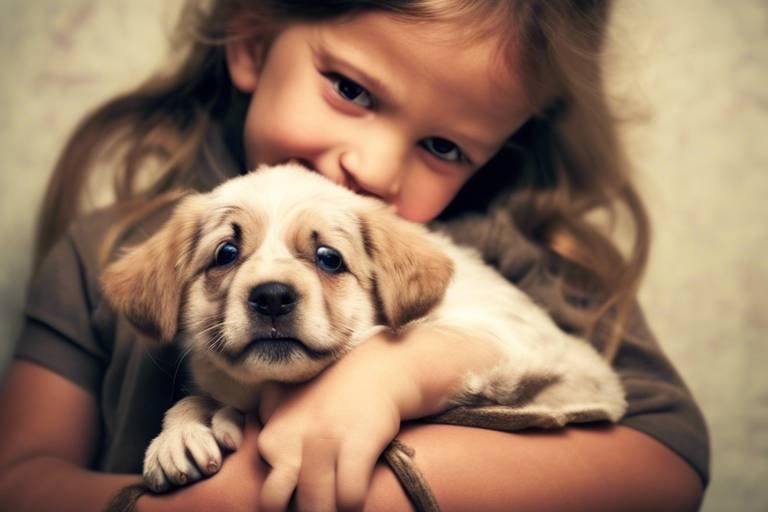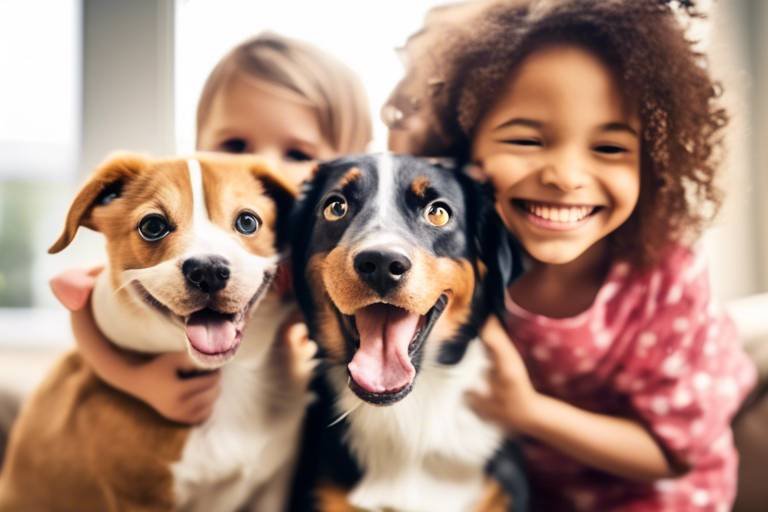How to Help Your Adopted Pet Cope with Change
Bringing a new pet into your home is like welcoming a new family member. It's an exciting time filled with joy and anticipation, but it can also be a bit overwhelming for your furry friend. Just imagine being uprooted from everything familiar and thrust into a new environment—it's a lot to process! In this article, we will explore effective strategies to assist your adopted pet in adjusting to their new surroundings and routines. Our goal is to ensure their emotional well-being while fostering a strong bond with their new family. So, let’s dive in and discover how you can make this transition as smooth as possible for your beloved companion!
Recognizing the emotional state of your adopted pet is crucial. Just like humans, pets experience a range of feelings during transitions, including excitement, anxiety, and fear. They may not be able to express these emotions verbally, but their body language can tell you a lot. For instance, if your pet is hiding, avoiding eye contact, or exhibiting destructive behavior, these could be signs of stress. It's essential to pay attention to these cues and respond with patience and understanding. Remember, your pet is adjusting to a whole new world, and your support can make all the difference.
A secure environment can significantly ease your pet's transition. Imagine how comforting it is to have a cozy nook to retreat to when things feel overwhelming. Here, we discuss how to set up a comfortable space that allows your pet to feel safe and relaxed in their new home. This space should be away from the hustle and bustle of daily activities, providing a quiet area where your pet can unwind. Consider using a crate, a designated room, or a cozy corner with their bed and toys to create this safe haven.
The placement of your pet's space matters. Ideally, it should be in a low-traffic area of your home, away from loud noises and sudden movements. Think of it as their personal sanctuary, where they can retreat and recharge. A corner of the living room or a quiet bedroom can be perfect. Just ensure they can see you from this spot, as your presence can provide reassurance during this adjustment period.
Providing familiar items can help your pet acclimate. Think of these comfort items as emotional anchors in a sea of change. Essential comfort items like blankets, toys, and even a piece of your clothing can ease the transition and provide emotional support. These items carry the scent of home and can help your pet feel more secure. So, don’t hesitate to sprinkle their new space with items that remind them of their previous home, as it can help bridge the gap between the old and the new.
Consistency is key for adopted pets. Just like humans thrive on routine, pets feel more secure when they know what to expect. In this section, we discuss the importance of establishing a daily routine that includes feeding, exercise, and playtime. A predictable schedule can help your pet adjust more quickly and reduce anxiety. Think of it as a comforting rhythm that guides them through their day, providing a sense of normalcy in a new environment.
A predictable feeding schedule can help your pet feel more at ease. By developing a consistent feeding routine that aligns with your pet's needs and preferences, you're not just providing food; you're offering stability. For instance, try to feed your pet at the same times each day, and stick to the same type of food they were eating before adoption, at least initially. This familiarity can alleviate stress and help them settle in more comfortably.
Regular physical activity is vital for your pet's well-being. Just like us, pets need to burn off energy and engage in play to stay happy and healthy. Incorporating playtime and exercise into your pet's daily routine can significantly reduce anxiety. Whether it's a game of fetch in the backyard or a leisurely walk around the block, these activities not only promote physical health but also strengthen the bond between you and your pet.
Using positive reinforcement can encourage desired behaviors. Rewarding your pet for good behavior during the adjustment process helps them feel more secure and confident in their new surroundings. Think of it as giving them a high-five for adapting well! Simple treats, praise, or extra cuddles can go a long way in reinforcing positive actions, making your pet feel loved and accepted.
Teaching basic commands can strengthen your bond. Training your pet not only helps them learn but also provides mental stimulation, which is crucial during their adjustment period. Start with simple commands like "sit," "stay," or "come." Use positive reinforcement techniques to reward them, and watch how quickly they respond. It’s like playing a game together, and it fosters trust and communication between you and your furry friend.
Trust is essential for a healthy relationship. Engaging in gentle interactions and maintaining consistent behavior can help your pet feel more secure. Spend quality time together, whether it’s through play, training, or simply relaxing on the couch. The more positive experiences they have with you, the stronger your bond will become, paving the way for a harmonious life together.
Sometimes, professional assistance is necessary. If your pet is struggling to adjust and showing signs of distress, it might be time to consult a veterinarian or animal behaviorist. They can provide valuable insights and strategies tailored to your pet's specific needs. Remember, seeking help is a sign of a responsible pet owner who wants the best for their furry friend!
Recognizing behavioral problems early is crucial. Common issues such as excessive barking, aggression, or withdrawal can arise during the adjustment period. By identifying these behaviors promptly, you can take proactive steps to address them. Keep a close eye on your pet’s actions and mood, and don’t hesitate to reach out for help if you notice anything concerning.
Various therapeutic options exist for stressed pets. From behavioral therapy to medication, there are numerous approaches to support your adopted pet's emotional health. Consult with a professional to explore the best options for your furry companion. Remember, every pet is unique, and what works for one may not work for another, so be open to trying different strategies until you find what helps your pet the most.
- How long does it take for an adopted pet to adjust? - Every pet is different, but it typically takes anywhere from a few days to several weeks for them to feel comfortable in their new home.
- What should I do if my pet shows signs of anxiety? - If your pet exhibits signs of anxiety, consider creating a safe space, establishing a routine, and using positive reinforcement techniques. If the anxiety persists, consult a professional.
- Can I use medication to help my pet adjust? - Yes, in some cases, medication prescribed by a veterinarian can help ease anxiety during the adjustment period. Always consult your vet before starting any medication.

Understanding Your Pet's Emotions
When you bring an adopted pet into your home, it's essential to recognize that they are not just animals; they are sentient beings with a rich tapestry of emotions. Just like humans, pets experience a range of feelings that can significantly influence their behavior and overall well-being. Transitioning to a new environment can be a whirlwind of emotions for your furry friend. They may feel confusion, fear, or even excitement as they navigate their new surroundings. Understanding these emotions is the first step in helping them adjust effectively.
One of the most common feelings pets experience during this transition is anxiety. Imagine moving to a new city where everything feels unfamiliar; that’s how your pet might feel in their new home. Look for signs of stress, such as excessive barking, hiding, or even destructive behavior. These are their ways of communicating that they are feeling overwhelmed. By being attentive and observant, you can identify when your pet is struggling and provide the support they need.
Furthermore, pets may also experience feelings of loss. If they were previously in a loving home, the change can create a sense of longing for their past life. This emotional baggage can manifest in various ways, including lethargy or withdrawal. To combat this, it’s crucial to create a warm and inviting environment that encourages them to feel secure and loved. You might consider surrounding them with familiar scents or items from their previous home to ease this transition.
To help you understand your pet's emotional landscape better, here are some common signs that indicate how they might be feeling:
- Tail Position: A low or tucked tail often signifies fear, while a wagging tail usually indicates happiness.
- Ears: Ears that are pinned back can mean anxiety, while ears that are perked up suggest curiosity or engagement.
- Body Language: A relaxed body posture indicates comfort, while a tense body may signal stress.
By paying close attention to these signs, you can better understand your pet's emotional state and take appropriate action to help them cope with their new reality. Remember, patience is key! Just like a new friendship, building trust and understanding takes time. With your love and support, your adopted pet can thrive in their new home, turning anxiety into joy and confusion into comfort.

Creating a Safe Space
When you bring an adopted pet into your home, one of the most important steps you can take is to create a safe space for them. This isn't just about giving them a corner of the house; it’s about crafting an environment where they can feel truly at ease. Imagine how overwhelming it must be for your furry friend to suddenly find themselves in a new place, surrounded by unfamiliar smells, sounds, and people. Just like we need a cozy nook to retreat to after a long day, our pets require a sanctuary that feels like home.
To start, think about the layout of your home. Choose a location that is quiet and away from the hustle and bustle of daily activities. This area should ideally be away from loud noises like the television or busy kitchen sounds. A spare room or a corner in the living room can work wonders. This location should be easily accessible to your pet, allowing them to retreat there whenever they feel anxious or overwhelmed. The goal is to provide a refuge where they can relax and recharge.
Choosing the right spot in your home is crucial for your pet's comfort. Here are a few tips to consider:
- Low Traffic Areas: Select a space where foot traffic is minimal. This reduces the likelihood of startling your pet.
- Natural Light: If possible, find a location that receives natural light. This can help create a warm and inviting atmosphere.
- Proximity to Family: While it should be a quiet space, being close enough to family can help your pet feel included and secure.
Once you've identified the ideal location, it’s time to fill it with the right items that will make your pet feel at home. Consider adding a comfortable bed or blanket where they can curl up. The softness of a familiar blanket can be incredibly soothing, almost like a warm hug. Additionally, placing a few of their favorite toys nearby can provide a sense of familiarity and comfort. These items serve not just as physical comforts, but also as emotional anchors that remind them of their previous home, reducing feelings of isolation and anxiety.
Incorporating essential comfort items into your pet’s safe space can significantly enhance their sense of security. Here are some must-have items:
- Blankets: A cozy blanket can provide warmth and comfort. If possible, use one that has their scent or a scent that is familiar to them.
- Toys: Familiar toys can help alleviate stress. Chew toys or soft plush toys can be particularly comforting.
- Water and Food Bowls: Having easy access to food and water can help your pet feel more settled in their space.
Moreover, consider adding an item that smells like you, such as an old t-shirt or a piece of clothing. This can create a sense of connection and safety for your pet, as they associate it with your presence. Remember, the goal is to create an environment that feels like a safe haven, where your pet can retreat whenever they need a break from the world.
In conclusion, creating a safe space for your adopted pet is one of the most compassionate things you can do to help them adjust to their new life. By choosing the right location and filling it with comforting items, you can significantly ease their transition and help them feel more at home. Just like us, our pets thrive in environments where they feel secure, loved, and understood.
Q1: How long does it take for an adopted pet to adjust to a new environment?
A1: The adjustment period can vary significantly depending on the pet's background, personality, and previous experiences. Some pets may adapt within a few days, while others might take weeks or even months. Patience is essential.
Q2: What should I do if my pet shows signs of stress?
A2: If your pet displays signs of stress, such as hiding, excessive barking, or destructive behavior, it's crucial to provide them with their safe space and comfort items. If the behavior persists, consider consulting a veterinarian or an animal behaviorist.
Q3: Can I use calming products to help my pet adjust?
A3: Yes! There are various calming products available, such as pheromone diffusers, calming collars, and anxiety wraps that can help soothe your pet during their adjustment period.
Choosing the Right Location
When it comes to creating a safe space for your adopted pet, the location is everything. Imagine moving to a new city where everything feels foreign; that's how your pet might feel in their new home. They need a spot that feels like their own little haven, a place where they can retreat to when the world feels overwhelming. So, how do you choose the right location? Let’s dive into some considerations that can make all the difference.
First and foremost, you want to find an area that is quiet and low-traffic. Pets, especially those who have experienced significant changes, can easily become anxious in bustling environments. A corner of a room that’s away from the hustle and bustle of daily activities is ideal. Think of it like finding a cozy coffee shop where you can unwind without the noise of the city. This space should be free from loud noises, such as the TV or busy kitchen sounds, to help your pet feel more at peace.
Next, consider the temperature and lighting of the space. A spot that is too hot or too cold can make your pet uncomfortable. You want to avoid placing their bed in direct sunlight or in a drafty area. Instead, aim for a location that offers a balance of natural light and warmth, creating a comfortable atmosphere. You might think of it as creating a perfect reading nook for yourself—somewhere that invites you to relax and enjoy your time.
Additionally, the proximity to family members is crucial. Pets are social creatures and often seek companionship. Placing their space near where you spend most of your time can help them feel more connected and less isolated. It’s like having your best friend nearby while you work on a project; their presence can be incredibly comforting. However, ensure that they still have a sense of privacy; a little corner where they can observe without being overwhelmed by attention is perfect.
It’s also essential to consider the safety of the chosen location. Make sure there are no hazards nearby, such as electrical cords, toxic plants, or small objects that could be ingested. A safe space allows your pet to explore without the constant worry of danger. Think of it as baby-proofing your home but for your furry friend. You want them to feel free to move around without the fear of getting hurt.
Finally, don’t forget to involve your pet in the decision-making process, if possible. Observe where they naturally gravitate toward when they first arrive. Sometimes, pets have a preference for certain areas based on their instincts. If they seem drawn to a particular spot, it might be their way of telling you where they feel most comfortable. Trust your gut and theirs; together, you can create a perfect sanctuary.
In conclusion, choosing the right location for your adopted pet's space is a vital step in helping them adjust to their new environment. By ensuring that the area is quiet, comfortable, safe, and close to family, you can create a welcoming atmosphere that allows your pet to thrive. Remember, it’s all about making them feel at home in their new surroundings.
Essential Comfort Items
When you bring your adopted pet home, one of the most important things you can do to help them adjust is to provide . These items serve as a bridge between their past life and their new environment, offering familiarity and a sense of security. Think of it as creating a cozy nest where they can feel safe and loved. Imagine how you would feel in a new place without any of your favorite belongings—your pet is no different!
First and foremost, consider providing a comfortable bed. A soft, plush bed can become your pet's sanctuary, a personal space where they can retreat when feeling overwhelmed. Look for beds that are appropriately sized for your pet, allowing them to stretch out comfortably. Additionally, placing the bed in a quiet corner of your home will help them feel more secure.
Another essential item is a familiar blanket or toy. If possible, bring something from their previous home that carries their scent. This could be a blanket, a favorite toy, or even a piece of clothing you’ve worn. The smell of something familiar can work wonders in helping your pet feel more at ease. If you don’t have anything from their past, consider purchasing a few toys that are soft and cuddly—these can become their new comfort items.
Moreover, food and water bowls should be easily accessible and placed in a designated area. Opt for bowls that are sturdy and not easily tipped over. Keeping their feeding area consistent will help your pet understand where to find their meals, contributing to a sense of routine and stability.
Finally, don’t underestimate the power of interactive toys. These items not only provide entertainment but also stimulate your pet mentally, which can be a great distraction from any anxiety they might be feeling during the transition. Look for toys that encourage play and exploration, as they can help your pet channel their energy positively.
In summary, the right comfort items can significantly ease your pet's transition into their new home. By providing a cozy bed, familiar scents, accessible feeding areas, and engaging toys, you’re not just offering physical comfort; you’re also nurturing their emotional well-being. Remember, every little detail counts in making your adopted pet feel loved and secure!
- What should I do if my pet refuses to use their new bed? - It may take some time for them to adjust. Try placing a familiar blanket or item from their previous home in the bed to encourage them.
- How long does it take for an adopted pet to adjust? - Every pet is different, but generally, it can take anywhere from a few days to several weeks for them to feel fully comfortable.
- Can I use calming sprays or diffusers to help my pet? - Yes, calming sprays and diffusers can provide additional comfort by creating a soothing atmosphere in your home.
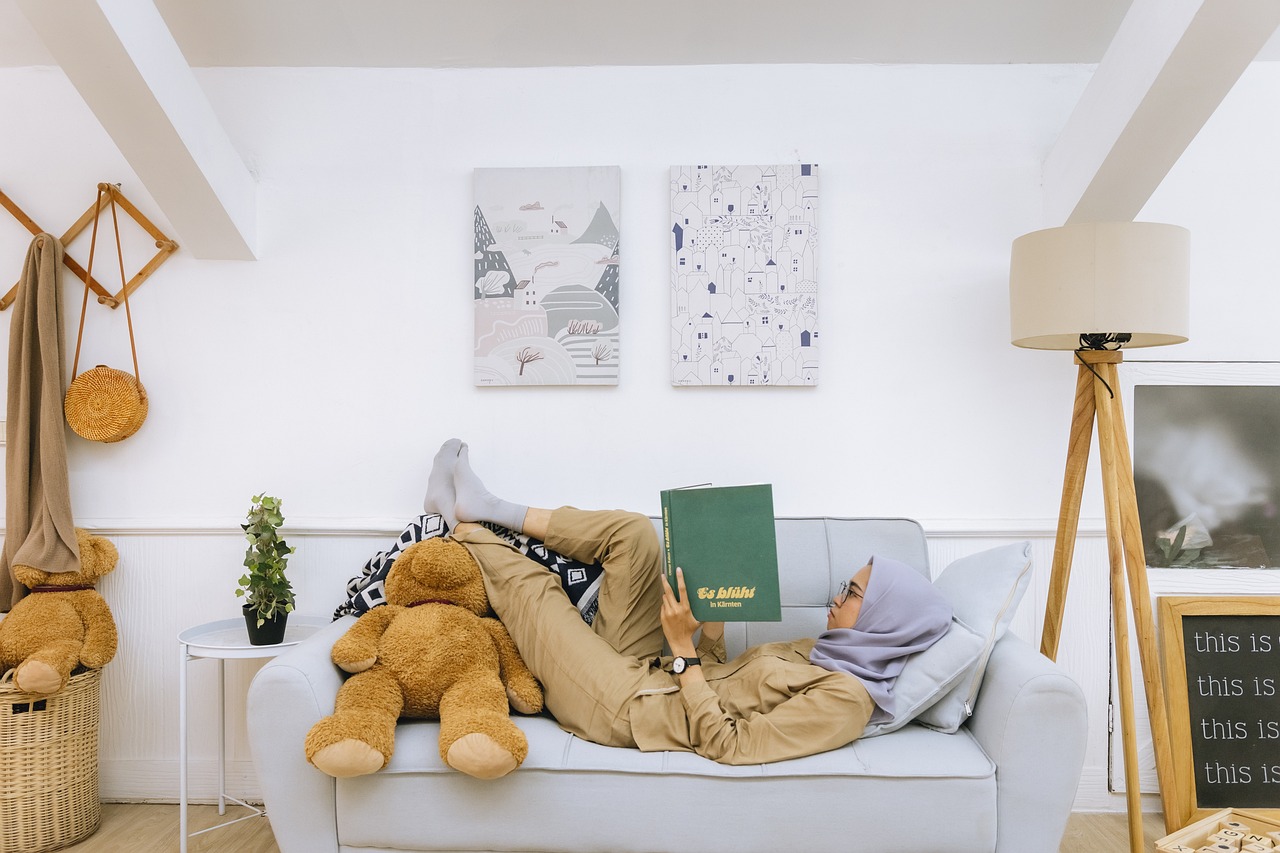
Establishing a Routine
Consistency is the bedrock of a happy and secure life for your adopted pet. Just like humans, pets thrive when they know what to expect. Imagine moving to a new city without a map or a guide; it can be overwhelming and stressful. This is precisely how your furry friend may feel in a new home. Establishing a daily routine can significantly ease their transition and help them feel more grounded in their new environment. A predictable schedule not only provides a sense of stability but also fosters a deeper bond between you and your pet.
When crafting this routine, think of it as building a framework for your pet's day. Start by incorporating essential activities such as feeding, exercise, and playtime. Each of these elements plays a vital role in your pet's emotional and physical well-being. By sticking to a consistent schedule, your pet will begin to understand when to expect meals, walks, and cuddle time, which can greatly reduce anxiety and stress.
For instance, consider the following components of a daily routine:
- Feeding: Choose specific times for meals, ensuring they align with your pet's natural hunger cues.
- Exercise: Regular walks or play sessions help burn off energy and keep your pet healthy.
- Playtime: Engage in interactive games that stimulate their mind and strengthen your bond.
By maintaining a routine, you create a predictable environment that can help your pet feel more secure. Think of it as a rhythm to their day; just as a musician relies on a beat, your pet will find comfort in the cadence of their new life with you. Over time, this routine will become second nature for both of you, and your pet will begin to associate these activities with safety and happiness.
To help you get started, here’s a simple table outlining a potential daily routine:
| Time | Activity |
|---|---|
| 7:00 AM | Feeding Time |
| 8:00 AM | Morning Walk |
| 10:00 AM | Playtime |
| 12:00 PM | Midday Snack |
| 5:00 PM | Evening Walk |
| 7:00 PM | Feeding Time |
| 9:00 PM | Wind Down Time (Cuddles & Relaxation) |
As you implement this routine, be patient and flexible. Every pet is unique, and it may take some time for them to adjust to their new schedule. If your pet seems anxious or overwhelmed, don't hesitate to modify the routine to better suit their needs. The goal is to create a loving and supportive environment where your pet can thrive.
In conclusion, establishing a routine is a powerful way to help your adopted pet feel safe and secure in their new home. With time and consistency, you’ll both find your rhythm, creating a harmonious life filled with love and joy.
Q1: How long does it take for an adopted pet to adjust to a new routine?
A1: The adjustment period can vary depending on the individual pet. Generally, it may take anywhere from a few days to several weeks for them to settle into a new routine.
Q2: What should I do if my pet doesn’t seem to adapt to the routine?
A2: If your pet is struggling, consider adjusting the routine to better fit their needs. Be patient and give them time to acclimate, and consult a veterinarian or animal behaviorist if necessary.
Q3: Can I change the routine once my pet has adjusted?
A3: Yes, you can modify the routine as needed. Just be sure to introduce changes gradually to avoid overwhelming your pet.
Feeding Schedules
Establishing a predictable feeding schedule is one of the most effective ways to help your adopted pet feel more comfortable in their new environment. Just like us, pets thrive on routine, and a consistent feeding time can provide them with a sense of security and stability. Imagine how chaotic life would feel if you never knew when your next meal was coming! For pets, this uncertainty can lead to anxiety and stress, which is the last thing you want for your new furry friend.
When creating a feeding schedule, consider your pet's age, size, and dietary needs. For instance, puppies and kittens typically require more frequent meals than adult pets. Here's a quick reference table to help you determine the best feeding frequency for your pet:
| Pet Age | Feeding Frequency |
|---|---|
| Puppies (up to 6 months) | 3-4 times a day |
| Adult Dogs (1-7 years) | 2 times a day |
| Senior Dogs (7+ years) | 2 times a day or as recommended by a vet |
| Kittens (up to 6 months) | 3-4 times a day |
| Adult Cats (1-7 years) | 2 times a day |
| Senior Cats (7+ years) | 2 times a day or as recommended by a vet |
Once you've determined the appropriate frequency, try to stick to the same times each day. This not only helps your pet adjust but also makes it easier for you to manage their feeding. For example, if you feed your dog at 8 AM and 6 PM, they’ll quickly learn to expect meals at those times, which can help reduce any anxiety they may feel about food availability.
Another important aspect to consider is the type of food you're offering. High-quality, nutritious food tailored to your pet's specific needs will make a significant difference in their overall well-being. If you're transitioning from one type of food to another, do it gradually over a week or so to prevent digestive issues. A sudden change can be overwhelming and might lead to gastrointestinal upset.
Additionally, keep an eye on your pet's weight and adjust the portion sizes as necessary. Overfeeding can lead to obesity, while underfeeding may leave your pet feeling deprived. Regularly consult with your veterinarian to ensure that your pet's dietary needs are being met and that they're maintaining a healthy weight.
In conclusion, a well-structured feeding schedule is a vital part of helping your adopted pet settle into their new home. By providing consistent meal times, quality food, and proper portion sizes, you can create a nurturing environment that fosters emotional well-being and happiness.
- How long does it take for an adopted pet to adjust to a new feeding schedule? Most pets will start to adapt within a few days, but it can take up to a few weeks for them to fully acclimate.
- What should I do if my pet refuses to eat? If your pet is not eating, check for any signs of stress or illness. If the problem persists, consult your veterinarian.
- Can I mix different types of pet food? Yes, but it's essential to transition gradually to avoid digestive issues. Always consult your vet for the best approach.
Exercise and Playtime
When it comes to helping your adopted pet settle into their new home, are not just optional; they are essential! Think of it this way: just like humans, pets need a way to release their pent-up energy. Imagine holding onto a balloon that’s filled to the brim with air; eventually, it’s going to burst if you don’t let some of that air out. Your pet is that balloon, and playtime is the release valve!
Engaging in regular physical activity is crucial for your pet's mental and emotional well-being. Not only does it help to reduce anxiety, but it also fosters a sense of routine and normalcy. By incorporating playtime into your daily schedule, you can create a stable environment that promotes your pet's overall happiness. So, what does a good exercise routine look like? Let’s break it down:
- Daily Walks: Taking your dog for a walk not only provides physical exercise but also exposes them to new sights, sounds, and smells. This sensory stimulation can help them feel more at home in their new environment.
- Interactive Play: Whether it’s tossing a ball, playing tug-of-war, or engaging with puzzle toys, interactive play is a fantastic way to bond with your pet while keeping them active. It’s like a mini workout for both of you!
- Scheduled Playdates: If your pet is social, consider arranging playdates with other friendly pets. This is a great way for them to learn social skills and expend energy in a fun, controlled environment.
But wait, there’s more! It’s not just about physical activity; mental stimulation is equally important. Incorporating training sessions and brain games into your pet’s routine can keep their mind sharp and engaged. For instance, teaching your pet new tricks or commands can be both mentally stimulating and rewarding. You might find that your pet thrives on the challenge, just like a student acing a pop quiz!
Here's a quick table summarizing some fun activities you can try with your pet:
| Activity | Benefits |
|---|---|
| Daily Walks | Improves physical fitness and exposes pets to new environments. |
| Interactive Toys | Provides mental stimulation and keeps pets entertained. |
| Agility Training | Enhances physical skills and builds confidence. |
| Hide and Seek | Encourages problem-solving and strengthens your bond. |
In conclusion, don’t underestimate the power of in helping your adopted pet adjust to their new life. By making these activities a regular part of your routine, you’ll not only help your pet feel more comfortable but also create lasting memories together. After all, a happy pet makes for a happy home!
Q: How much exercise does my pet need?
A: The amount of exercise varies by species, breed, and age. Generally, dogs benefit from at least 30 minutes to 2 hours of exercise daily, while cats enjoy shorter, more intense play sessions.
Q: What if my pet doesn’t seem interested in play?
A: It’s normal for some pets to be hesitant at first. Try different types of toys or activities to see what sparks their interest. Patience is key!
Q: Can I over-exercise my pet?
A: Yes, over-exercising can lead to fatigue or injury. Always monitor your pet for signs of exhaustion and adjust their activity levels accordingly.

Positive Reinforcement Techniques
When it comes to helping your adopted pet adjust to their new home, positive reinforcement is a game changer. Imagine trying to learn a new skill without any encouragement—frustrating, right? That’s how your pet feels when they’re navigating the unfamiliar territory of a new environment. By using positive reinforcement techniques, you can create a supportive atmosphere that encourages your furry friend to explore and adapt. This method focuses on rewarding good behavior rather than punishing bad behavior, fostering a sense of security and trust.
So, how can you effectively implement positive reinforcement? Start by identifying behaviors you want to encourage. Whether it’s sitting calmly, using the bathroom outside, or simply coming when called, make a list of these target behaviors. Each time your pet exhibits one of these behaviors, immediately reward them with a treat, praise, or affection. This immediate reinforcement helps your pet associate the behavior with something positive, making them more likely to repeat it in the future.
Here’s a simple table to illustrate how you can structure your reinforcement strategy:
| Behavior | Reward | Timing |
|---|---|---|
| Sitting on command | Treat and praise | Immediately after sitting |
| Going outside to potty | Praise and a favorite toy | Right after they finish |
| Calm behavior during visitors | Extra playtime | During the visit |
In addition to treats, consider incorporating playtime as a reward. Pets love to play, and using their favorite game as a reward can be incredibly effective. For instance, if your dog sits on command, follow it up with a game of fetch. This not only reinforces the behavior but also strengthens your bond through shared fun.
Another essential aspect of positive reinforcement is consistency. Just like a child learns better in a stable environment, your pet will thrive when they know what to expect. Make sure that everyone in your household is on the same page regarding the behaviors you’re encouraging and the rewards you’re using. This consistency helps prevent confusion and builds your pet’s confidence over time.
As you work on training your pet, remember that patience is key. Some pets may take longer to adjust and learn than others. Celebrate small victories along the way and don’t get discouraged if progress seems slow. Every little step counts, and your encouragement will make a world of difference. Building trust through positive reinforcement not only helps your pet feel secure but also lays the foundation for a lifelong bond filled with love and companionship.
Trust is the cornerstone of any relationship, especially between you and your adopted pet. Engaging in gentle interactions can significantly enhance this trust. Simple activities like petting, grooming, or just sitting quietly together can help your pet feel more at home. The more positive experiences you create, the more your pet will learn to see you as a source of comfort and safety. Remember, your energy and demeanor play a huge role—stay calm and positive, and your pet will likely mirror that energy.
- What is positive reinforcement? Positive reinforcement is a training method that encourages desired behaviors by rewarding them with treats, praise, or affection.
- How long does it take for my pet to adjust to a new home? Every pet is different, but typically, it can take anywhere from a few days to a few weeks for them to feel comfortable in their new environment.
- Can I use positive reinforcement for behavioral issues? Yes, positive reinforcement can be used to address various behavioral issues by rewarding good behaviors and gradually shaping your pet's actions.
Training Basics
Training your adopted pet is not just about teaching them commands; it's about building a stronger bond and creating a sense of security in their new environment. Imagine stepping into a new school without knowing anyone or understanding the rules—overwhelming, right? That’s how your pet feels! By introducing them to basic commands, you help them navigate their new world, making it less daunting.
Start with simple commands like “sit,” “stay,” and “come.” These foundational commands not only enhance communication but also establish a routine that your pet can rely on. Use positive reinforcement techniques, such as treats or praise, whenever they successfully follow a command. This approach not only encourages good behavior but also boosts their confidence, making them feel more at home.
Consistency is key in training. Make sure everyone in your household uses the same commands and rewards. If one person says “down” and another says “off,” it can confuse your pet and hinder their progress. To keep track of your training sessions and progress, consider creating a simple table that outlines what commands you've taught and how your pet responds:
| Command | Response | Date Taught |
|---|---|---|
| Sit | Good | 01/01/2023 |
| Stay | Needs Improvement | 01/03/2023 |
| Come | Good | 01/05/2023 |
Another essential aspect of training is to incorporate regular interaction into your routine. This could be through short training sessions or simply engaging in playtime. The more you interact with your pet, the more they learn about your expectations and the more they feel like a valued member of the family. Just like any relationship, trust is built over time through consistent and positive interactions.
In conclusion, training your adopted pet should be a fun and rewarding experience for both of you. Remember, patience is crucial! Each pet learns at their own pace, and celebrating small victories along the way can make a world of difference. So grab those treats, stay positive, and watch your furry friend thrive!
- How long should training sessions be? Aim for short sessions of about 5-10 minutes to keep your pet engaged and prevent frustration.
- What if my pet doesn’t respond to commands? Be patient and consistent. If needed, consult a professional trainer for additional guidance.
- Can I use toys as rewards? Absolutely! Many pets respond well to toys, which can be a great alternative to treats.
Building Trust Through Interaction
Building trust with your adopted pet is one of the most rewarding experiences you can have as a pet owner. Just like any new relationship, it takes time and patience. Imagine meeting a new friend who has been through a tough time; they might be a bit shy at first, right? Your furry companion is no different! They come from various backgrounds, and their past experiences can shape how they perceive the world around them. To foster this bond, you need to engage in gentle interactions that make your pet feel safe and valued.
Start by creating a calm environment where your pet can approach you on their terms. It’s essential to be aware of their body language. For instance, if your cat is hiding under the couch or your dog is cowering in the corner, they might need some space. On the flip side, if they approach you with their tail wagging or purring softly, that’s a green light to interact! Use a soft voice and avoid sudden movements; think of yourself as a gentle breeze rather than a thunderstorm. This approach helps to reassure them that you mean no harm.
Regular, positive interactions can significantly help in building trust. Here are some effective methods to enhance your connection:
- Gentle Petting: Start with light strokes and gradually increase as your pet becomes more comfortable. Pay attention to their reactions; if they lean into your hand, that’s a good sign!
- Playtime: Engage in fun activities that your pet enjoys. Whether it’s tossing a ball for your dog or dangling a string for your cat, playtime can break the ice and create joyful memories.
- Training Sessions: Incorporate short training sessions using positive reinforcement. Rewarding your pet with treats or praise when they respond correctly can help them associate you with positive experiences.
Moreover, consistency is vital. Make it a point to spend quality time with your pet every day, even if it's just for a few minutes. This routine helps them understand that you are a stable presence in their life. Over time, they will learn to trust you more and feel secure in your companionship.
Lastly, don’t forget to celebrate the small victories! Each time your pet shows signs of trust—whether it’s allowing you to pet them or coming to you for comfort—acknowledge it with affection. This reinforcement builds a stronger bond and encourages them to continue opening up. Remember, trust is a journey, not a race. With your love and patience, your adopted pet will flourish and become a cherished member of your family.
Q: How long does it take for an adopted pet to trust me?
A: The timeline varies depending on the pet's past experiences and personality. Some pets may warm up within days, while others might take weeks or even months. Patience is key!
Q: What should I do if my pet shows signs of aggression?
A: If your pet displays aggressive behavior, it’s crucial to give them space and avoid confrontation. Consult a professional trainer or behaviorist for guidance tailored to your pet’s needs.
Q: Can I speed up the trust-building process?
A: While you can't rush trust, you can create a positive environment and engage in gentle interactions that encourage your pet to feel safe and loved. Consistency and patience are your best friends!

Seeking Professional Help
When it comes to helping your adopted pet adjust to their new environment, sometimes you need to call in the experts. Just like how we might seek guidance from a therapist or a doctor during tough times, our furry friends can benefit from professional help too. If your pet is showing signs of distress that you can't seem to alleviate, it's crucial to consider reaching out to a veterinarian or an animal behaviorist. These professionals have the expertise to assess your pet's emotional state and provide tailored solutions that can make a world of difference.
It's important to recognize when your pet's behavior crosses from typical adjustment issues into something more serious. For instance, if your pet is exhibiting persistent anxiety, aggression, or destructive behaviors, these could be indicators that they need more than just time to adjust. Early intervention can prevent these problems from escalating, so being proactive is key. Here are some common behavioral issues that may arise during the adjustment period:
- Excessive barking or whining: This could indicate anxiety or a need for attention.
- Refusal to eat: A lack of appetite can be a sign of stress or discomfort.
- Destructive behavior: Chewing on furniture or scratching at doors may indicate frustration or boredom.
- Hiding or withdrawal: If your pet is constantly seeking out secluded spots, they may be feeling overwhelmed.
If you notice any of these behaviors, don't hesitate to seek professional help. A veterinarian can rule out any underlying medical issues that could be contributing to your pet's behavior. Meanwhile, an animal behaviorist specializes in understanding the psychology of pets and can provide strategies for managing their anxiety and helping them feel secure in their new home.
In addition to behavioral assessments, there are various therapeutic options available for stressed pets. These might include behavioral therapy, which focuses on modifying your pet's behavior through positive reinforcement techniques, or in some cases, medication may be recommended to help manage anxiety levels. The goal is to create a comprehensive plan tailored to your pet's specific needs.
Ultimately, seeking professional help is not a sign of failure; rather, it shows your commitment to your pet's well-being. Just as we would reach out for help when feeling overwhelmed, our pets deserve the same level of care and attention. By collaborating with professionals, you can ensure that your adopted pet receives the best support possible during their transition, paving the way for a happy and fulfilling life together.
Here are some common queries pet owners have regarding seeking professional help for their adopted pets:
- When should I consider professional help for my pet? If your pet shows persistent signs of anxiety, aggression, or any behavior that concerns you, it's time to consult a professional.
- What can a veterinarian do for my pet's behavioral issues? A veterinarian can assess your pet's health to rule out medical issues and may recommend treatment options, including medication or referrals to behaviorists.
- How can an animal behaviorist assist my pet? An animal behaviorist can provide tailored strategies to manage your pet's anxiety and help modify undesirable behaviors through training techniques.
Identifying Behavioral Issues
When you bring an adopted pet into your home, it's like opening a new chapter in both your lives. However, this transition can come with its fair share of challenges. One of the most critical aspects of helping your new furry friend settle in is identifying any behavioral issues that may arise. Just like humans, pets can exhibit signs of stress, anxiety, or even fear when faced with a new environment. It’s essential to be vigilant and recognize these behaviors early on to provide the necessary support.
Common indicators of behavioral issues may include:
- Aggression: This can manifest as barking, growling, or even biting. Aggressive behavior often stems from fear or insecurity, so it's vital to address it promptly.
- Excessive Barking or Whining: If your pet is vocalizing more than usual, it could be a sign of distress. Pay attention to the context—are they trying to tell you something?
- Destructive Behavior: Chewing furniture, scratching doors, or digging can indicate that your pet is feeling anxious or bored. This behavior often arises from a lack of stimulation or a need for attention.
- Withdrawal: If your pet is hiding, avoiding interaction, or seems uninterested in their surroundings, they may be feeling overwhelmed. This behavior can be particularly common in pets that have experienced trauma.
Understanding these signs is just the beginning. It’s equally important to consider the context of your pet's behavior. For instance, a dog that growls when approached while eating may simply be displaying protective instincts rather than outright aggression. Similarly, a cat that hides under the bed after a loud noise isn’t necessarily anti-social; they might just need some time to adjust. Observing your pet in various situations can provide valuable insights into their emotional state.
Creating a stress diary can also be beneficial. Documenting your pet's behaviors, triggers, and any changes in their routine can help you identify patterns. For example, if your dog becomes anxious every time someone knocks on the door, you might need to work on desensitization techniques. This diary can also be a useful tool if you decide to consult a professional later on, as it provides them with a clear picture of your pet's behavior over time.
Lastly, remember that every pet is unique. What may seem like a behavioral issue in one animal could be entirely normal in another. Take the time to understand your pet's personality and preferences. This understanding will not only help you identify issues more accurately but also strengthen the bond between you and your furry companion.
Q: What should I do if I notice aggressive behavior in my adopted pet?
A: It's crucial to remain calm and avoid punishment, as this can escalate the situation. Instead, consult a professional trainer or behaviorist who can help you address the issue safely.
Q: How long does it usually take for an adopted pet to adjust?
A: The adjustment period varies by pet, but it can take anywhere from a few days to several weeks. Patience and consistency are key during this time.
Q: Should I be concerned if my pet is hiding a lot?
A: While some hiding is normal as they acclimate to their new home, excessive hiding can indicate stress. Monitor their behavior and consider creating a safe space for them.
Q: Can I train my adopted pet to overcome behavioral issues?
A: Yes, many behavioral issues can be addressed through training and positive reinforcement. However, if the problems persist, seeking professional help is recommended.
Therapeutic Options
When you've done everything you can to help your adopted pet feel at home, and they still seem to be struggling, it might be time to consider some . Just like humans, pets can experience emotional distress, and sometimes they need a little extra support to get through tough transitions. Whether it’s behavioral therapy or medication, there are various avenues to explore that can help your furry friend regain their confidence and joy.
One of the first steps is to consult with a veterinarian or an animal behaviorist. These professionals can assess your pet's specific needs and recommend appropriate interventions. For instance, they might suggest a behavior modification program tailored to your pet's unique situation. This could include strategies to address anxiety, fear, or aggression, which are common issues during the adjustment period.
In some cases, medication can be a beneficial tool to help your pet cope with their emotions. It's important to remember that medication is not a one-size-fits-all solution, and it should always be used in conjunction with behavioral techniques. Here are some common types of medications that might be prescribed:
| Medication Type | Purpose | Common Examples |
|---|---|---|
| Antidepressants | Help manage anxiety and depression | Fluoxetine, Sertraline |
| Anti-anxiety Medications | Provide immediate relief from anxiety | Diazepam, Clonazepam |
| Behavioral Modifiers | Alter specific behaviors | Clomipramine |
It's crucial to monitor your pet's response to any medication and maintain open communication with your vet. Adjustments may be necessary to find the right balance that works for your pet. Additionally, some owners find success with alternative therapies. Techniques such as acupuncture, massage therapy, and even aromatherapy can provide soothing effects and help alleviate stress. These holistic approaches can complement traditional treatments and offer your pet a well-rounded support system.
Lastly, don’t underestimate the power of a consistent routine and plenty of love and patience. Sometimes, just knowing that they are in a safe and loving environment can be the best therapy of all. Every pet is unique, so it’s essential to tailor your approach based on their individual needs. By exploring these therapeutic options, you can help your adopted pet navigate their new world with greater ease and confidence.
- What signs should I look for to know if my pet needs therapy?
Common signs include excessive barking, hiding, aggression, or changes in eating habits. If your pet seems unusually anxious or fearful, it may be time to seek professional help. - How do I find a qualified animal behaviorist?
Look for certified professionals through reputable organizations such as the Animal Behavior Society or your local veterinary clinic for recommendations. - Are there side effects to pet medications?
Yes, like all medications, there can be side effects. Always discuss these with your veterinarian before starting any treatment. - Can I use holistic therapies alongside traditional treatments?
Absolutely! Many pet owners find that combining treatments can enhance their pet's overall well-being, but always consult your vet first.
Frequently Asked Questions
- How can I tell if my adopted pet is stressed?
Pets often show signs of stress through changes in behavior. Look for signs like excessive barking, hiding, or changes in eating habits. If your pet seems more withdrawn than usual, it might be feeling overwhelmed. Just like us, they have their own ways of expressing discomfort!
- What should I include in my pet's safe space?
A safe space should be cozy and comforting! Include familiar items like their favorite blanket, a few toys, and a comfy bed. Think of it as their little sanctuary where they can relax and feel secure, away from the hustle and bustle of your home.
- Why is establishing a routine important for my pet?
Establishing a routine helps your pet feel more secure and reduces anxiety. Just like humans thrive on structure, pets do too! Regular feeding, playtime, and walks can create a sense of normalcy, making them feel more at home.
- What are some positive reinforcement techniques I can use?
Positive reinforcement is all about rewarding good behavior! You can use treats, praise, or playtime as rewards when your pet follows commands or exhibits good behavior. It’s like giving them a high-five for being awesome!
- When should I seek professional help for my pet?
If your pet shows persistent signs of distress or exhibits behavioral issues that you can't manage, it might be time to consult a veterinarian or an animal behaviorist. Think of them as the pet whisperers who can help decode your furry friend’s feelings!
- What are some common behavioral issues in adopted pets?
Common issues include separation anxiety, excessive barking, or destructive behaviors. If your pet seems overly anxious or acts out, it’s essential to address these behaviors early on to help them adjust better to their new home.
- Are there therapeutic options available for stressed pets?
Absolutely! There are various therapeutic options, including behavioral therapy, calming supplements, and sometimes medication. It’s important to discuss these options with a professional to find the best fit for your pet’s needs.

